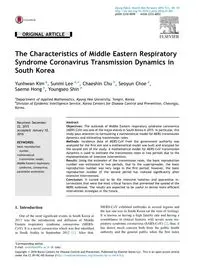
2016 The Characteristics of Middle Eastern Respiratory Syndrome Coronavirus Transmission Dynamics in South Korea PDF
Preview 2016 The Characteristics of Middle Eastern Respiratory Syndrome Coronavirus Transmission Dynamics in South Korea
- ORIGINAL ARTICLE - The Characteristics of Middle Eastern Respiratory Syndrome Coronavirus Transmission Dynamics in South Korea Yunhwan Kim a, Sunmi Lee a,*, Chaeshin Chu b, Seoyun Choe a, Saeme Hong a, Youngseo Shin a aDepartment of Applied Mathematics, Kyung Hee University, Yongin, Korea. bDivision of Epidemic Intelligence Service, Korea Centers for Disease Control and Prevention, Cheongju, Korea. Received: December 22, 2015 Accepted: January 10, 2016 KEYWORDS: basic reproduction number, mathematical transmission model, Middle Eastern respiratory syndrome, coronavirus, parameter estimation Abstract Objectives: The outbreak of Middle Eastern respiratory syndrome coronavirus (MERS-CoV) was one of the major events in South Korea in 2015. In particular, this study pays attention to formulating a mathematical model for MERS transmission dynamics and estimating transmission rates. Methods: Incidence data of MERS-CoV from the government authority was analyzed for the first aim and a mathematical model was built and analyzed for the second aim of the study. A mathematical model for MERS-CoV transmission dynamics is used to estimate the transmission rates in two periods due to the implementation of intensive interventions. Results: Using the estimates of the transmission rates, the basic reproduction number was estimated in two periods. Due to the superspreader, the basic reproduction number was very large in the first period; however, the basic reproduction number of the second period has reduced significantly after intensive interventions. Conclusion: It turned out to be the intensive isolation and quarantine in- terventions that were the most critical factors that prevented the spread of the MERS outbreak. The results are expected to be useful to devise more efficient intervention strategies in the future. 1. Introduction One of the most significant events in South Korea in 2015 was the introduction and diffusion of Middle Eastern respiratory syndrome coronavirus (MERS- CoV). It is a novel coronavirus which was first identified in Saudi Arabia in September 2012 [1]. After that, MERS-CoV exhibited outbreaks in several regions and the last one was in South Korea (at the time of writing). It is known as having a high fatality rate and having a resemblance in clinical features with severe acute res- piratory syndrome coronavirus (SARS-CoV) [2], thus, it has drawn much concern both from the public health authority and the general public when the first index *Corresponding author. E-mail:
